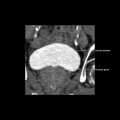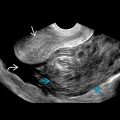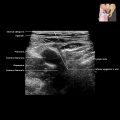KEY FACTS
Terminology
- •
Biliary ductal dilatation, dilated ducts
Imaging
- •
Tubular anechoic fluid-filled structures accompanying portal veins in extrahepatic and intrahepatic segments
- •
Intrahepatic ductal dilatation
- ○
Dilatation of ductal diameter > 2 mm
- ○
- •
Extrahepatic ductal dilatation
- ○
Dilatation of common hepatic/bile duct > 6-7 mm or > 40% of diameter of adjacent portal vein
- ○
Top Differential Diagnoses
- •
Portal vein cavernoma
- •
Thrombosed portal vein branch
- •
Venovenous collaterals
- •
Peribiliary cysts
- •
Choledochal cyst
Pathology
- •
Obstructive causes
- ○
Intrahepatic: Calculus, recurrent pyogenic cholangitis, sclerosing/AIDS cholangitis, cholangiocarcinoma, etc.
- ○
Extrahepatic: Calculus, stricture, pancreatic head adenocarcinoma, cholangiocarcinoma, lymph node compression, etc.
- ○
- •
Nonobstructive causes
- ○
Advanced age
- ○
Previous cholecystectomy
- ○
Congenital disease (e.g., choledochal cyst)
- ○
Hepatic artery stenosis in liver transplant recipients
- ○
Clinical Issues
- •
Presentation
- ○
Often presents with obstructive jaundice: Painless or right upper quadrant pain
- ○
Scanning Tips
- •
Confirm with color or power Doppler that tubular structure is nonvascular, and follow tubular structure to porta hepatis to confirm communication with common bile duct
- •
Dilated bile ducts are often tortuous and may demonstrate posterior acoustic enhancement










